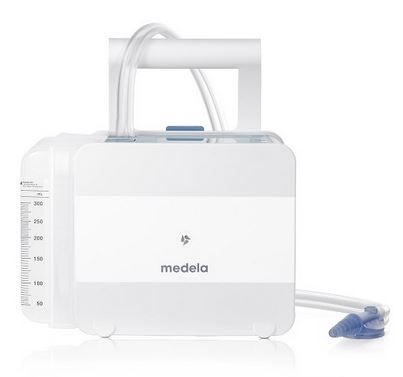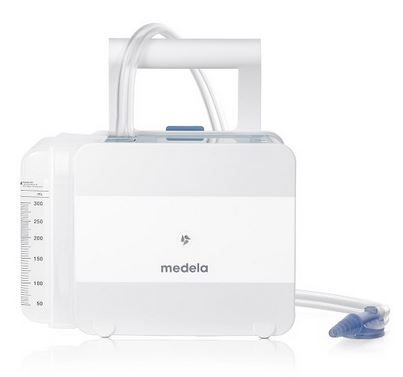THORACIC SUCTION PUMP (Medela Thopaz+)
Valid Article
THORACIC SUCTION PUMP (Medela Thopaz+)
Definition
An electrically-powered, portable device, which may include noninvasive accessories, intended to generate negative pressure specifically for aspiration of the pleural cavity and/or mediastinum. It is a dedicated device intended to remove fluids (e.g., blood), secretions, and air to allow for the normal expansion/function of the lungs. The device may incorporate a display and may include collection containers or tubing; it does not include patient contact devices (e.g., catheter).
Specifications
Thopaz+ is a portable chest drainage system from Medela, Switzerland. The device delivers regulated individualized suction and continuously monitors and records air leakage and fluid loss. Thopaz+ is equipped with a suction pump, a digital display, a rechargeable battery, standard chest tube adaptors and disposable collection canisters.
- Compact, portable vacuum source
- Regulated pressure at the patient's chest
- Digital display of air leak, fluid and pressure
- Notifications on system status and Catheter patency indicator
- Data recording and transfer to PC
Technical specifications
- Power supply: 100-240VAC, 0,8-0,4A, 47-63Hz.
- A digital display provides data in real time as well as a 24-hour graph of the air leak
- Low vacuum
- 10 kPa
- 75 mmHg
- 100 mbar/cmH2O
- Low flow 5 l/min
Thopaz+ can be operated from the mains power supply, from the docking station or with the integrated lithium-ion battery (< 10 Wh).
Dimensions
Weight: 1 kg
Transport Dangerous Goods
- UN3481 Lithium ion batteries contained in equipment
- Class: 9
- Packing Instructions: 967 Section II
- The label must include the UN code of the battery + an emergency number to contact in case of an incident
- Limit per package:
- Pax A/C (Passengers & Cargo Aircraft) = 5 kg
- CAO (Cargo Aircraft Only) = 5 kg
Instructions for use
MSF requirements
Small, easy-to-use medical equipment designed to drain air and fluid from the pleural space, or chest, allowing the lung to re-inflate. Patients may undergo chest drainage, for example, after lung resection or because of a pneumothorax.
Description approved by referent of OCB (Jonathan Delchambre) in August 2023.





![[EEMDTHSA104] (thoracic suction Medela Thopaz) VACUOMETER 077.1456](/web/image/product.template/581396/image_256/%5BEEMDTHSA104%5D%20%28thoracic%20suction%20Medela%20Thopaz%29%20VACUOMETER%20077.1456?unique=371da4c)
![[EEMDTHSC101] (thoracic suction Medela Thopaz) BOTTLE 800ml, sterile, s.u.](/web/image/product.template/581397/image_256/%5BEEMDTHSC101%5D%20%28thoracic%20suction%20Medela%20Thopaz%29%20BOTTLE%20800ml%2C%20sterile%2C%20s.u.?unique=c4e322b)
![[EEMDTHSC102] (thoracic suction Medela Thopaz) HOSE one connexion, sterile](/web/image/product.template/581398/image_256/%5BEEMDTHSC102%5D%20%28thoracic%20suction%20Medela%20Thopaz%29%20HOSE%20one%20connexion%2C%20sterile?unique=371da4c)
![[EEMDTHSC103] (thor. suction Medela Thopaz) HOSE double connexion, sterile](/web/image/product.template/581399/image_256/%5BEEMDTHSC103%5D%20%28thor.%20suction%20Medela%20Thopaz%29%20HOSE%20double%20connexion%2C%20sterile?unique=371da4c)